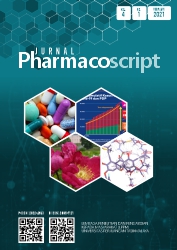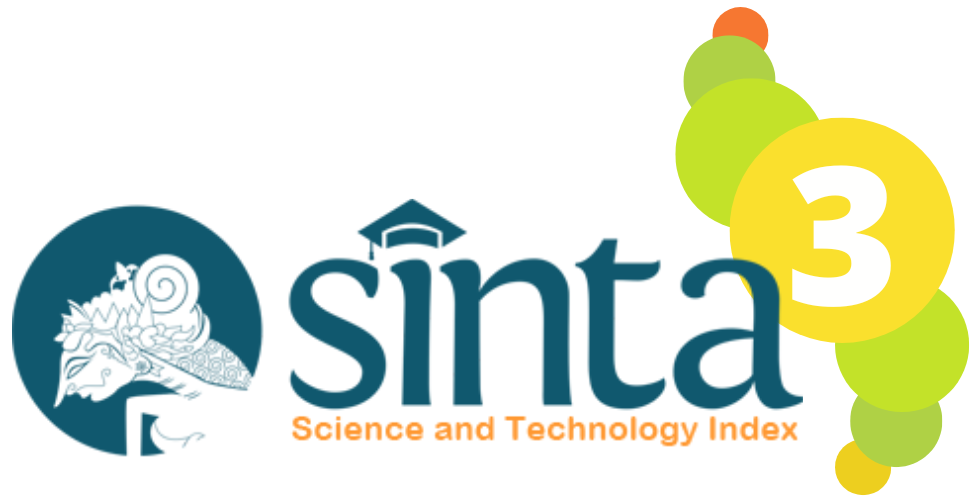STUDI POLA PERESEPAN ANTIDIARE ANAK DI PUSKESMAS KOTA BANDUNG
DOI:
https://doi.org/10.36423/pharmacoscript.v4i1.619Keywords:
Pola peresepan, Antidiare, AnakAbstract
Prevalensi diare pada anak di Jawa Barat memiliki angka yang cukup tinggi dibandingkan dengan kelompok usia lain yaitu sebesar 30,81%, dan prevalensi diare di Kota Bandung adalah 10,48%. UNICEF (2019) menyatakan bahwa hanya sekitar 44% anak-anak yang mengalami diare, menerima pengobatan yang direkomendasikan. Studi ini bertujuan untuk memperoleh gambaran pola peresepan dan rasionalitas peresepan obat antidiare pada pasien anak. Studi observasional dan deskriptif ini dilakukan secara retrospektif pada pasien anak di salah satu Puskesmas di Kota Bandung. Subjek penelitian yang diikutsertakan dalam studi ini adalah pasien anak laki-laki dan perempuan usia 1-12 tahun yang terdiagnosis diare dan mendapatkan obat antidiare pada periode kunjungan Januari – Maret 2020. Obat antidiare yang paling banyak diresepkan pada pasien anak di puskesmas tersebut adalah oralit (84%), selanjutnya zink (68%), kaolin pektin (4%) dan attapulgit (4%), serta terdapat 6 pasien (12%) yang menerima terapi antibiotik kotrimoksazol. Persentase peresepan antibiotik untuk diare non-spesifik pada pasien anak yaitu sebesar 4,35%. Sebagian besar pasien (46%) menerima terapi kombinasi oralit dan zink. Penilaian rasionalitas penggunaan obat mengacu pada pedoman Kementrian Kesehatan RI. Penggunaan obat antidiare pada pasien anak telah 100% tepat indikasi dan tepat interval waktu pemberian, 84% tepat pemilihan obat, 88% tepat dosis, dan 96% tepat lama pemberian. Ketidakrasionalan penggunaan obat antidiare ditemukan sebanyak 15 kasus pada peresepan obat zink dan 4 kasus pada peresepan antibiotik kotrimoksazol. Tidak ditemukan adanya interaksi obat. Peran apoteker dalam optimaliasi penggunaan obat yang rasional pada praktik klinik, khususnya dalam penanganan diare pada anak, masih perlu ditingkatkan.
References
American Society of Health System Pharmacists. (2014). AHFS Drug Information. USA: ASHP Incorporation.
Brooks, W. A., Santosham, M., Roy, S. K., Faruque, A. S., Wahed, M. A., Nahar, K., Khan, A. I., Khan, A. F., Fuchs, G. J., & Black, R. E. (2005). Efficacy of zinc in young infants with acute watery diarrhea. The American Journal of Clinical Nutrition, 82(3), 605–610. https://doi.org/10.1093/ajcn.82.3.605
Canani, R. B., & Ruotolo, S. (2006). The dawning of the “zinc era” in the treatment of pediatric acute gastroenteritis worldwide? Journal of Pediatric Gastroenterology and Nutrition, 42(3), 253–255. https://doi.org/10.1097/01.mpg.0000214159.60445.9a
Ciccarelli, S., Stolfi, I., & Caramia, G. (2013). Management strategies in the treatment of neonatal and pediatric gastroenteritis. Infection and Drug Resistance, 6, 133–161. https://doi.org/10.2147/IDR.S12718
Depkes RI. (2011). Buku Saku Petugas Kesehatan Lintas Diare. Jakarta: Departemen Kesehatan RI.
Erlina Burhan, Susanto, A. D., Nasution, S. A., Ginanjar, E., Pitoyo, C. W., Susilo, A., Firdaus, I., Santoso, A., Juzar, D. A., Arif, S. K., Wulung, N. G. . L., Adityaningsih, D., Syam, A. F., Rasmin, M., Rengganis, I., Sukrisman, L., Damayanti, T., Wiyono, W. H., Prasenohadi, … Aniwidyaningsih, W. (2020). PEDOMAN TATALAKSANA COVID-19 Edisi 2. Jakarta
Florez, I. D., Al-Khalifah, R., Sierra, J. M., Granados, C. M., Yepes-Nuñez, J. J., Cuello-Garcia, C., Perez-Gaxiola, G., Zea, A. M., Hernandez, G. N., Veroniki, A. A., Guyatt, G. H., & Thabane, L. (2016). The effectiveness and safety of treatments used for acute diarrhea and acute gastroenteritis in children: Protocol for a systematic review and network meta-analysis. Systematic Reviews, 5(1), 1–9. https://doi.org/10.1186/s13643-016-0186-8
Florez, I. D., Veroniki, A. A., Al Khalifahn, R., Yepes-Nuñez, J. J., Sierra, J. M., Vernooij, R. W. M., Acosta-Reyes, J., Granados, C. M., Perez-Gaxiolan, G., Cuello-Garcia, C., Zea, A. M., Zhang, Y., Foroutan, N., Guyatt, G. H., & Thabane, L. (2018). Comparative effectiveness and safety of interventions for acute diarrhea and gastroenteritis in children: A systematic review and network meta-analysis. PLoS ONE, 13(12), 1–22. https://doi.org/10.1371/journal.pone.0207701
IDAI. (2015). Buku Ajar Gastroenterologi-Hepatologi (Jilid 1). Jakarta: IDAI.
Indonesian, T. (2020). We Don ’ t Cover Things Up , Indonesia Says Amid Doubts Over Its Covid-19 Handling Issue to Asean Chair Brunei.
Indriani, L., Fitriyanti, D., & Azzikri., A. A. (2019). Penilaian Rasionalitas Pengobatan Diare Pada Balita di Puskesmas Bogor Utara Tahun 2016. Fitofarmaka, 9, 11.
Kemenkes, R.I. (2007). Pedoman Pengobatan Dasar di Puskesmas 2007. Jakarta: Kemenkes RI. 1–247.
Kemenkes, R.I. (2011). Situasi diare di Indonesia. Jurnal Buletin Jendela Data & Informasi Kesehatan, 2, 1–44.
Kemenkes, R.I. (2011). Modul penggunaan obat rasional. Jakarta: Kemenkes RI, 1–192.
Kemenkes, R.I. (2012). MODUL Penggerakan Penggunaan Obat Rasional. Dirjen Binfar, Kemenkes RI.
Kemenkes, R.I. (2015). Buku Bagan Manajemen Terpadu Balita Sakit (MTBS). Jakarta: Kemenkes RI.
Kemenkes, R.I. (2016). Profil Kesehatan Indonesia 2015. Jakarta: Kemenkes RI.
Kemenkes, R.I. (2018). Hasil Utama Riset Kesehatan Dasar Indonesia. Balitbangkes.
Kemenkes, R.I. (2019). Profil Kesehatan Indonesia 2018. Jakarta: Kemenkes RI.
Markum., A. H. (1998). Ilmu Kesehatan Anak; Buku Ajar Jilid 1, Bagian Kesehatan Anak. Universitas Indonesia.
Paparan Subdit POR Direktorat Binfar. (2014). Dirjen Binfar (kemkes.go.id) tersedia: https://farmalkes.kemkes. go.id/2014/06/materi-paparan-rakontek-direktorat-bina-pelayanan-kefarmasian/ [diakses pada tanggal 26 Juli 2020]
Patel, A. B., Dhande, L. A., & Rawat, M. S. (2003). Economic evaluation of zinc and copper use in treating acute diarrhea in children: A randomized controlled trial. Cost Effectiveness and Resource Allocation, 1, 1–10. https://doi.org/10.1186/1478-7547-1-7
Ravelomanana, L., Tsifiregna, R. L., Rakotomalala, L. H., Razafimahatombo, C., & Ravelomanana, N. (2018). Prescription des médecins dans une diarrhée aiguë du nourrisson à Antananarivo, Madagascar. Médecine et Santé Tropicales. 3–5.
Russel, T., Hellewell, J., Abbott, S., Jarvis, C. I., van Zandvoort, K., Flasche, S., Eggo, R., Edmunds, W. J., & Kucharski, A. J. (2020). Using a delay-adjusted case fatality ratio to estimate under-reporting. CMMID Repository, 1–6. https://cmmid.github.io/topics/ covid19/current-patterns-transmission/ global-time-varying-transmission.html
Santoso, B. (2010). Peta Klasifikasi Antibiotika dan Prinsip Pemilihan danPemakaiannya Dalam Klinik. Laboratorium Farmakologi Klinik Fakultas Kedokteran UGM.
Seo, J. H., Shim, J. O., Choe, B. H., Moon, J. S., Kang, K. S., & Chung, J. Y. (2019). Management of Acute Gastroenteritis in Children: A Survey among Members of the Korean Society of Pediatric Gastroenterology, Hepatology, and Nutrition. Pediatric Gastroenterology, Hepatology and Nutrition, 22(5), 431–440. https://doi.org/10.5223/pghn.2019.22.5.431
Sukardi, S., Yusran, S., & Tina, L. (2016). Faktor-Faktor yang Berhubungan dengan Kejadian Diare Pada Balita Umur 6-59 Bulan di Wilayah Kerja Puskesmas Poasia Tahun 2016. Jurnal Ilmiah Mahasiswa Kesehatan Masyarakat, 3, 10.
Susono, R. F., Sudarso., & Galistiani, G. F. (2014). Cost Effectiveness Analysis Pasien Demam Tifoid Pediatrik Menggunakan Cefotaxime danm Cloramphenicol Di Instalasi Rawat Inap RSUD Prof. Dr. Margono Soekarjo. Pharmacy, 11, 88.
Tjay, T. H., & Raharja, K. (2002). Obat-Obat Penting : Khasiat, Penggunaan dan Efek-efek Sampingnya. PT. Gramedia.
UNICEF. (2019). Diarrhoeal Disease.
Vecchio, A. Lo, Liguoro, I., Bruzzese, D., Scotto, R., Parola, L., Gargantini, G., & Guarino, A. (2014). Adherence to guidelines for management of children hospitalized for acute diarrhea. Pediatric Infectious Disease Journal, 33(11), 1103–1108. https://doi.org/ 10.1097/INF.0000000000000396
Downloads
Published
Issue
Section
License
Copyright (c) 2021 Alfi Nurul Islamiyah, Linda Purnamawati Suherman, Ambarsundari Ambarsundari, Abdul Aziz Muslim Shahibul Wafa

This work is licensed under a Creative Commons Attribution-ShareAlike 4.0 International License.
Authors who publish with this journal agree to the following terms:
- Authors retain copyright and grant the journal right of first publication, with the work [SPECIFY PERIOD OF TIME] after publication simultaneously licensed under a Creative Commons Attribution License that allows others to share the work with an acknowledgement of the work's authorship and initial publication in this journal.
- Authors are able to enter into separate, additional contractual arrangements for the non-exclusive distribution of the journal's published version of the work (e.g., post it to an institutional repository or publish it in a book), with an acknowledgement of its initial publication in this journal.
- Authors are permitted and encouraged to post their work online (e.g., in institutional repositories or on their website) prior to and during the submission process, as it can lead to productive exchanges, as well as earlier and greater citation of published work (See The Effect of Open Access).









